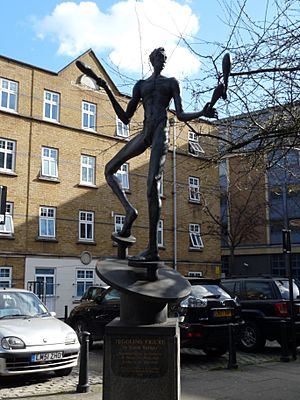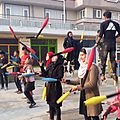Juggling facts for kids
Juggling is a fun skill where you throw and catch several objects in the air. The goal is to keep at least one object flying at all times. It's like a dance with objects!
Juggling can be a cool hobby, an amazing performance art, or even a sport. It involves repeating the same movements over and over. This repetition is what makes it tricky to learn but super rewarding to master. The easiest trick to start with is called the three-ball cascade.
What is Juggling?
Juggling is more than just throwing balls. It includes many ways of skillfully moving objects. People often juggle for entertainment, to create art, or as a competitive sport. It takes a lot of practice to get good at it.
Juggling Props
Jugglers use many different items. The most common props are balls, beanbags, and rings. Some jugglers like to use more exciting objects, like knives or even fire torches!
Here are some other cool juggling props:
History of Juggling
Juggling has been around for a very long time! The oldest known record of juggling comes from Egypt. It's shown in a tomb painting from about 1994-1781 B.C. That's almost 4,000 years ago! This ancient art shows how people have enjoyed juggling for centuries.
Images for kids
-
Children performing juggling as part of the International Jugglers' Association supported Mobile Mini Circus for Children
-
Animation of 3 ball cascade (also known as a Siteswap 3)
-
This ancient wall painting appears to depict jugglers. It was found in the 15th tomb of the Karyssa I area, Egypt. According to Dr. Bianchi, associate curator of the Brooklyn Museum "In tomb 15, the prince is looking on to things he enjoyed in life that he wishes to take to the next world. The fact that jugglers are represented in a tomb suggests religious significance." ... "round things were used to represent large solar objects, birth, and death."
-
Juggling four racquets, Daniel Hochsteiner
-
Juggling is often used in circus arts, such as in Jennifer Miller's Circus Amok
-
Street juggler Mark Lippard on stilts at the Lexington Barbecue Festival
-
Gentleman juggler Thom Wall demonstrates a trick using a teacup, saucer, and tray in his show On the Topic of Juggling at the Emerald Room in St Louis, Missouri.
See also
 In Spanish: Malabarismo para niños
In Spanish: Malabarismo para niños












